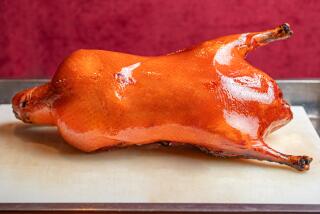Christmas goose is starting to cook
- Share via
It turns out that Mother Goose has been hard at work.
Once upon a time, goose dinner was a holiday favorite, trimmings and all. “Christmas is coming, the goose is getting fat, please put a penny in the old man’s hat,” goes the old nursery rhyme.
Perhaps the most famous roasted goose was served by the Cratchit family in Charles Dickens’ “A Christmas Carol,” complete with applesauce and mashed potatoes.
But goose, a greasy, gamy bird, never quite caught on in America -- until recently.
Pushing its way back onto holiday menus, the goose is finding some room at the table along with ever-popular turkey, ham and prime rib. Now, in Southern California and across the nation, grocers and restaurateurs are seeing goose as a way to fatten their holiday profits.
Tuxedo-clad waiters at the Ritz Restaurant and Garden at Fashion Island in Newport Beach expect to serve 4,000 to 5,000 goose dinners and lunches during the holiday period.
“It is very popular. People start asking about it in October,” said Beccy Rogers, general manager of the 30-year-old Newport Beach institution, where a goose dinner in one of the Ritz’s black leather booths will set you back $35. “By early November we take duck off the menu and put goose on.”
Whole Foods and rival upscale grocery chain Bristol Farms will sell more than 4,000 geese at their Southern California stores this holiday season. Bristol Farms also offers precooked goose dinners, complete with sun-dried cherry stuffing and other side dishes.
Even Ralphs has it. And shoppers can find fully roasted goose for sale online.
It’s no surprise to farmers. About 240,000 geese are headed to market this year, up 65% from 2000.
The typical Bristol Farms store sells 100 to 120 geese during the holiday season. That’s up from 80 to 90 over the last two to three years, said Paul Davis, Bristol Farms’ director of meat.
But still these goose merchants know it’s not for everyone.
“It’s strong, greasy, all dark meat. I would say it is an acquired taste,” Davis said.
“The flavor profile does not appeal to a lot of people,” said Michael Hacaga, a meat coordinator for Whole Foods Markets Inc.
Whether it is a grocery store or a restaurant, the poultry industry figures that close to 90% of the birds are sold from the period that starts with Thanksgiving and ends with New Year’s Day.
Goose sales have become a small and steady business that caters to the culinarily adventurous and to natives of goose-eating European nations, Hacaga said.
“Goose has been a Christmas tradition in our family for generations,” Susan Pinsky said. The Pasadena resident learned to cook the bird from her Prague, Czech Republic-born grandmother.
“I tried cooking it myself once, but my father complained that it was dry. He was right,” Pinsky said.
Now she purchases roasted goose from Bristol Farms for Christmas, and often Thanksgiving. But she still serves it with a blueberry sauce made from a family recipe.
Eating goose isn’t cheap.
Pinsky figures she will spend about $200 this Christmas to feed goose to a gathering of 20 family members.
Bristol Farms’ precooked goose is $11.99 a pound, and it also sells frozen uncooked birds for $4.69 a pound. A fresh goose -- typically 8 to 12 pounds -- sells for $6.59 a pound at Whole Foods Markets.
“Goose is pricier and always will be. They are harder to grow and more expensive to feed than other poultry,” said Jim Schiltz of Schiltz Goose Farm Inc. in Sisseton, S.D.
Whereas it takes about 2 1/2 pounds of feed to grow a pound of turkey, geese require more than 7 pounds, said Schiltz, whose company processes about 200,000 geese a year and is America’s largest producer.
Turkey is still the No. 1 holiday bird -- Americans consume about 1,000 times more turkeys than geese.
Despite the goose-centric literary and cultural traditions of Britain and Europe, America developed into a nation of turkey eaters. The Pilgrims ate turkey at Thanksgiving for good reason. Turkeys are native to North America. Colonists found them plentiful, easy to catch and good to eat.
The daunting nature of cooking goose also is a major factor holding back the fowl’s popularity.
“My mother complained about how difficult it was to cook,” Pinsky said. It makes a mess in the kitchen. Goose sheds 2 to 3 pounds of grease as it cooks. It requires a deep rack and a deeper pan. The fat splatters and smokes.
“Cooking a goose is a big event,” Schiltz said. “It takes a long time and people are afraid of it.”
That was true even in Dickens’ time. In “A Christmas Carol,” the Cratchit children become excited when they smell the family’s goose cooking at the nearby bakery. Poorer families in Victorian England lacked ovens large enough to cook the bird, so they would pay for oven space at the local bakeries.
“People don’t have as much cooking knowledge or time as they have in previous generations,” said Duane Wulf, a professor of meat science at South Dakota State University
That’s one reason cooked goose holiday dinners sell well at Bristol Farms: Shoppers get the traditional holiday meal but none of the mess.
Schiltz also sells a cooked goose. It is a frozen, roasted bird available online or by phone. Selling for $33 to $40, depending on the size, the goose takes 90 minutes to reheat. The company also sells sliced smoked goose breast.
Pinsky said good goose is worth the price.
“It’s not unlike duck but with a fuller taste and a little tougher texture,” she said. “And you don’t eat as much goose as you do turkey because it is so rich. There really is nothing like it.”
More to Read
Eat your way across L.A.
Get our weekly Tasting Notes newsletter for reviews, news and more.
You may occasionally receive promotional content from the Los Angeles Times.











